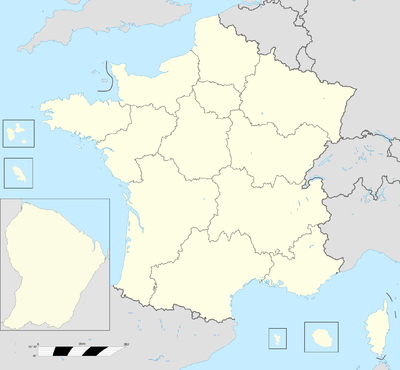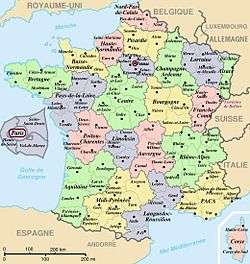Administrative divisions of France

|
This article is part of the series on
Administrative divisions of France |
|
(incl. overseas regions) |
|
(incl. overseas departments) |
|
Urban communities |
|
Others in Overseas France
Overseas collectivities |
The administrative divisions of France are concerned with the institutional and territorial organization of French territory. There are many administrative divisions, which may have political (local government), electoral (districts), or administrative (decentralized services of the state) objectives.
The different status
Regions
The French republic is divided into 18 regions : 13 in metropolitan France and 5 in overseas France.
Metropolitan regions
As of 1 January 2016, metropolitan France is divided into the following:[1]
- 13 regions, including Corsica;[2] although Corsica is formally a territorial collectivity, it is considered equivalent to a region. (local authority)
- The regions are subdivided into 96 departments. (local authority)
- The departments are subdivided into 323 arrondissements. (not a public or legal entity)
- The arrondissements are subdivided into 1,995 cantons. (not a public or legal entity)
- The cantons are subdivided into 36,529 communes. (local authority)
- Three urban communes (Paris, Marseille, and Lyon) are further divided into municipal arrondissements. There are 20 arrondissements of Paris, 16 arrondissements of Marseille, and nine arrondissements of Lyon.
- The city of Marseilles is also divided into 8 municipal sectors. Each sector is composed with two arrondissements.
- there are also 730 associated communes (as of January 2006), formerly independent communes which were merged with larger communes but have retained some limited degree of autonomy (e.g. the commune of Lomme which was absorbed by Lille in 2000 and transformed into an "associated commune" inside the commune of Lille)
Furthermore, as of January 2009, there exist 2,585 intercommunal structures grouping 34,077 communes (93.2% of all the communes of metropolitan France), with 87.4% of the population of metropolitan France living in them.[3] These intercommunal structures are:
- 16 Urban communities (communautés urbaines, or CU)
- 167 Agglomeration communities (communautés d'agglomération, or CA)
- 2,397 Commune communities (communautés de communes, or CC)
- 5 Syndicates of New Agglomeration (syndicats d'agglomération nouvelle, or SAN), a category being phased out
Overseas regions
- five overseas regions (régions d'outre-mer, or ROM): Guadeloupe, French Guiana, Martinique, Mayotte and Réunion, which have the same status as metropolitan regions.
- each overseas region is coextensive with an overseas department (département d'outre-mer, or DOM), again with the same status as departments in metropolitan France. The first four overseas departments were created in 1946 and preceded the four overseas regions, Mayotte became a DOM in 2011. The dual structure overseas region/overseas department, with two separate assemblies administering the same territory, results from the extension of the regional scheme to the overseas departments in the 1970s. Each overseas region/department may transform into a single structure, with the merger of the regional and departmental assemblies, but voters in Martinique and Guadeloupe rejected this in two referendums in 2003. In Réunion the creation of a second department for the southern part of the island has been debated for some time.
- the overseas departments are subdivided into 12 arrondissements (Mayotte does not have arrondissements)
- the 12 arrondissements are further subdivided into 153 cantons with Mayotte having another 19 cantons
- the 172 cantons are composed of 129 communes (in the five DOM, there are more cantons than communes, unlike in metropolitan France, because many communes are divided into several cantons, whereas in metropolitan France in general cantons are made up of several communes, except in large communes like Toulouse or Lille which are divided into several cantons)
- Furthermore, as of January 1, 2009, there exist 16 intercommunal structures in the overseas departments, grouping 89 communes (79.5% of all the communes of the overseas departments), with 83.2% of the population of the overseas departments living in them intercommunal structures.[3] These intercommunal structures are:
- 7 Agglomeration communities
- 9 Commune communities
Overseas collectivities
The French Republic include five overseas collectivities (collectivités d'outre-mer, or COM): French Polynesia, Saint-Barthélemy, Saint-Martin, Saint-Pierre and Miquelon and Wallis and Futuna
- French Polynesia (designated as an "overseas country", French: pays d'outre-mer) is divided into 5 administrative subdivisions (subdivisions administratives). For elections it is divided into 6 electoral districts (circonscriptions électorales) which differ slightly from the 5 administrative subdivisions. The 5 administrative subdivisions are divided into 48 communes. There also exist some associated communes as in metropolitan France.
- Saint-Barthélemy (designated as a "collectivity", French: collectivité) is a new overseas collectivity created on February 22, 2007. It was previously a commune inside the Guadeloupe department. The commune structure was abolished and Saint-Barthélemy is now one of only three permanently inhabited territories of the French Republic with no commune structure. There are no cantons and arrondissements either.
- Saint-Martin (designated as a "collectivity", French: collectivité) is also a new overseas collectivity created on February 22, 2007. It was also previously a commune inside the Guadeloupe department. The commune structure was abolished and Saint-Martin is now one of only three permanently inhabited territories of the French Republic with no commune structure. There are no cantons and arrondissements either.
- Saint-Pierre and Miquelon (designated as a "territorial collectivity", French: collectivité territoriale, the same designation as Corsica which is a region and not an overseas collectivity) is divided into 2 communes with no arrondissements or cantons.
- Wallis and Futuna (designated as a "territory", French: territoire) is divided into 3 districts (circonscriptions territoriales) which exactly match the three traditional chiefdoms (royaumes coutumiers) with their traditional kings still at their head, the only kings currently recognized in the French Republic. These 3 districts are: Uvea, Sigave, and Alo. Uvea is the most populous and is further divided into 3 wards (districts in French): Hahake, Mua, and Hihifo. Wallis and Futuna is one of only three permanently inhabited territories of the French Republic with no communes (the others being Saint-Barthélemy and Saint-Martin). It also has no arrondissements or cantons.
Overseas territory
1 overseas territory (territoire d'outre-mer, or TOM): the French Southern and Antarctic Lands, which have no permanent population and no communes.
- the French Southern and Antarctic Lands are divided into 5 districts (districts in French):
- 1. Kerguelen Islands
- 2. Crozet Islands
- 3. Amsterdam Island and Saint Paul Island
- 4. Adelie Land.
- 5. the Scattered Islands (îles Éparses), a collection of six non permanently inhabited islands in the Indian Ocean: Banc du Geyser, Bassas da India, Europa, Juan de Nova, Glorioso, and Tromelin. These were previously administered separately but they have been joined with the French Southern and Antarctic Lands since February 2007.
Uninhabited island directly under the authority of the Minister of Overseas France
- Clipperton Island: uninhabited island in the Pacific Ocean off the coast of Mexico which is directly under the authority of the Minister of Overseas France in Paris (until February 2007 it was administered by the high-commissioner of the French Republic in French Polynesia). Since the Scattered Islands were joined with the French Southern and Antarctic Lands also in February 2007, Clipperton Island is now the only island left in this category.
New Caledonia
- 1 special collectivity: New Caledonia, whose status is unique in the French Republic: it is the only French local government which is not a territorial collectivity (although its subdivisions are territorial collectivities). As agreed in the 1998 Nouméa Accord, a self-determination referendum will be held between 2014 and 2018 to decide the future status of New Caledonia.
- It is divided into 3 provinces
- the provinces are subdivided into 33 communes
Territorial collectivities
French subdivisions that have a (limited) freedom of administration are called territorial collectivities. Among them are regions, departments, communes, overseas collectivities, provinces (only present in New Caledonia) and the territorial collectivity of Corsica which belongs to no category (but is usually grouped with the regions). New Caledonia is unique as it is not a territorial collectivity.
General rules
Citizens from all parts of France, including the overseas administrative divisions, vote in national elections (presidential, legislative), and all of the collectivities are represented in the Senate.
List of departments by region
- Grand Est
- 08 Ardennes
- 10 Aube
- 51 Marne
- 52 Haute-Marne
- 54 Meurthe-et-Moselle
- 55 Meuse
- 57 Moselle
- 67 Bas-Rhin
- 68 Haut-Rhin
- 88 Vosges
- Nouvelle-Aquitaine
- 16 Charente
- 17 Charente-Maritime
- 19 Corrèze
- 23 Creuse
- 24 Dordogne
- 33 Gironde
- 40 Landes
- 47 Lot-et-Garonne
- 64 Pyrénées-Atlantiques
- 79 Deux-Sèvres
- 86 Vienne
- 87 Haute-Vienne
- Auvergne-Rhône-Alpes
- 01 Ain
- 03 Allier
- 07 Ardèche
- 15 Cantal
- 26 Drôme
- 38 Isère
- 42 Loire
- 43 Haute-Loire
- 63 Puy-de-Dôme
- 69 Rhône
- 73 Savoie
- 74 Haute-Savoie
- Bourgogne-Franche-Comté
- 21 Côte-d'Or
- 25 Doubs
- 39 Jura
- 58 Nièvre
- 70 Haute-Saône
- 71 Saône-et-Loire
- 89 Yonne
- 90 Territoire de Belfort
- Brittany (Bretagne)
- 22 Côtes-d'Armor
- 29 Finistère
- 35 Ille-et-Vilaine
- 56 Morbihan
- Centre-Val de Loire
- 18 Cher
- 28 Eure-et-Loir
- 36 Indre
- 37 Indre-et-Loire
- 41 Loir-et-Cher
- 45 Loiret
- Corsica (Corse)
- 2A Corse-du-Sud
- 2B Haute-Corse
- Île-de-France
- 75 Paris
- 77 Seine-et-Marne
- 78 Yvelines
- 91 Essonne
- 92 Hauts-de-Seine
- 93 Seine-Saint-Denis
- 94 Val-de-Marne
- 95 Val-d'Oise
- Occitania
- 09 Ariège
- 11 Aude
- 12 Aveyron
- 30 Gard
- 31 Haute-Garonne
- 32 Gers
- 34 Hérault
- 46 Lot
- 48 Lozère
- 65 Hautes-Pyrénées
- 66 Pyrénées-Orientales
- 81 Tarn
- 82 Tarn-et-Garonne
- Hauts-de-France
- 02 Aisne
- 59 Nord
- 60 Oise
- 62 Pas-de-Calais
- 80 Somme
- Normandy (Normandie)
- 14 Calvados
- 27 Eure
- 50 Manche
- 61 Orne
- 76 Seine-Maritime
- Pays-de-la-Loire
- 44 Loire-Atlantique
- 49 Maine-et-Loire
- 53 Mayenne
- 72 Sarthe
- 85 Vendée
- Provence-Alpes-Côte d'Azur
- 04 Alpes-de-Haute-Provence
- 05 Hautes-Alpes
- 06 Alpes-Maritimes
- 13 Bouches-du-Rhône
- 83 Var
- 84 Vaucluse
- Overseas departments
(the following are both departments and regions)- 971 Guadeloupe
- 972 Martinique
- 973 French Guiana
- 974 Réunion
- 976 Mayotte
- Overseas collectivities
- 975 Saint-Pierre and Miquelon
- 977 Saint-Barthélemy
- 978 Saint-Martin
- 986 Wallis and Futuna
- 987 French Polynesia
- Sui generis collectivity
- 988 New Caledonia
- Overseas territory
- 984 French Southern and Antarctic Territories (including France's Antarctic claim and the Scattered Islands in the Indian Ocean)
- 989 Clipperton Island
Historical divisions

In the Medieval period, the territory of modern metropolitan France was occupied by a complex mosaic of more or less independent entities. Their gradual incorporation into France may be followed in the article Territorial formation of France.
Historically, France was divided into provinces; see Provinces of France.
See also
- Décentralisation
- List of fifteen largest French metropolitan areas by population
- French overseas departments and territories
- Zone d'études et d'aménagement du territoire (ZEAT), the eight statistical divisions of metropolitan (mainland) France.
References
- ↑ "Circonscriptions administratives au 1er janvier 2015 : comparaisons régionales" [Administrative constituencies of 1 January 2015: regional comparisons] (in French). INSEE. Archived from the original on 30 April 2014. Retrieved 5 July 2015.
- ↑ "La réforme territoriale" (in French). Government of France. 18 December 2015. Retrieved 1 January 2016.
- 1 2 Direction générale des collectivités locales (DGCL), Ministry of the Interior. "Intercommunalité - Bilan statistique 2009" (in French). Archived from the original on 6 March 2009. Retrieved 2009-03-24.